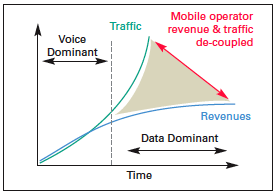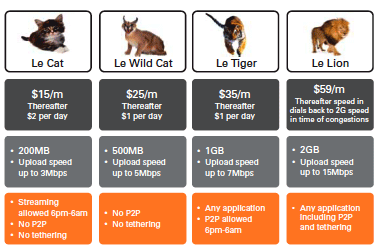Policy management and charging need to work together in order to really monetise data services. But integrating the two is not easy.
The combination of powerful mobile devices and the always-on lifestyle leads to an evergrowing demand for mobile broadband. Better networks allow us to consume and produce more content; improved devices allow us to do more than merely make a voice call, while the opening up of the mobile eco-systems allows application developers to offer more compelling services for various portable platforms.
The introduction of the iPhone and its successors, coupled with flat-rate data pricing models, paved the way to an explosive growth in data traffic that is challenging service providers who need to ensure the capacity on their networks. This is having a dramatic impact on their financial bottom line and in their future ability to turn data into a profitable business.

So, how can service providers optimise their monetisation capabilities when it comes to data?
The first intuitive answer we hear all around us is, “We have to use policy management to better manage the network and optimise the resources we have.” But wait: Should a policy management solution, advanced as it may be, be solely responsible for the challenges of monetisation?
Policy management can optimise network traffic and facilitate better network operations, but when it comes to monetization it’s all about charging systems and how flexible and sophisticated they are.
Policy management and charging need to work together in order to really monetise data services. But integrating the two is not easy.
The greatest challenge
In a recent study from Heavy Reading* on the evolving nature of policy management, service providers rated the integration between policy management and charging as the single biggest challenge for data monetisation. The ability to have one solution that spans both policy aspects and still offers advanced charging capabilities is highly sought after.
Why?
Integrated charging and policy management adds the ability to provide flexible, dynamic rating based on multi-dimensional characteristics such as time, location, type of service consumed and – last but not least – subscriber information. Couple this with policy management capabilities on the network side and you now have a set of tools that allows you to effectively monetise data services.
Here’s an example: Mark is a ‘bandwidth hog’. For the same flat rate that other subscribers are paying, he consumes more network resources and bandwidth. This leads to congestion on the network, an inferior customer experience for other subscribers, and could lead to additional costs for service providers as they need to upgrade their networks to support the Marks of the world without being able to charge additional fees.
Integrating policy management with charging capabilities can overcome this problem in several ways. Mark could be offered a package in which he gets more bandwidth at lower rates during off-peak hours or he could be offered a premium data package which guarantees high bandwidth throughout the day, but at a higher price than a standard data package. In both cases charging and policy management need to work together.
Competing in the new world of data through price differentiation
Most service providers today deploy simple pricing strategies for data services, namely flatrate usage plans or ‘all-you-can-eat’ and this is where the challenges lie. First, these plans create network congestion and may lead to a price war in which prices will fall dramatically. Flat-rate plans also make it difficult for service providers to assure their profitability.
In fact, service providers need to ask themselves whether they should just supply the connection to the connected world or whether there is a way for them to have a much more significant role in this new world of data?
Indeed, service providers may be leaving money on the table by ignoring the potential for generating more revenues from high-bandwidth subscribers – consumers who are willing to pay a premium for better service.
But this could be a very different story when you have policy management and charging integrated and working together. Service providers will be able to create advanced pricing models and schemes for their data services and offer packages to various subscriber profiles, from the standard casual surfer all the way up to a power user needing high bandwidth at his or her fingertips.
Let’s look at some usage scenarios to better understand how policy management and charging can improve data monetisation capabilities:
- Tiered pricing. One of the most discussed paths to data monetisation is tiered pricing. It revolves around the idea that data plans pricing should be a combination of several elements; usage (200 megabyte vs. 2 gigabyte), speed (of either download or upload) time (day, month, week, peak/off-peak…), priority or type of customer (consumer, business, VIP, government…), type of application (P2P, streaming, video…) and device type (smartphone, broadband modem, e-book reader…). The various combinations create multiple possibilities of new pricing schemes and business models, and all depend solely on the fact that there's a tight integration between the charging engine that will rate these schemes and the policy management element that will execute it on the network level.
- On-demand bandwidth boost. Just imagine the following scenario: You have subscribers who are watching movies on their mobile handsets. Most of the time this is not HD quality. But what if you could engage with them and offer, in real-time, to upgrade their viewing experience to an HD level based on your network resources for a one-time fee. And this could either be a proactive offer from the service provider or emanate from a subscriber request. Once the offer is accepted, the customer is charged accordingly and the network allocates the required bandwidth to make sure the HD movie is viewed correctly.
- Dynamic pricing. How about letting the price be determined dynamically based on network congestion and the demand for the service? Service providers could dynamically take into account various parameters when setting prices, before offering them to customers in real-time. Advice of charge, willingness to pay and network congestion can affect the price that is offered at any given time. For example, watching the new season of House during peak times will be priced differently than watching the same episode at off-peak times.

Final thoughts
On the road to data profitability service provides need to manage data consumption more intelligently. Coupling charging and policy management is the solution for operators, as long as it goes hand in hand with customer targeting, personalisation and satisfaction. Taking a customer-centric approach rather than network-centric approach by focusing on services rather than traffic patterns is the key.

 The authors are Rafi Kretchmer and Guy Hilton from the Revenue Management division of Amdocs
The authors are Rafi Kretchmer and Guy Hilton from the Revenue Management division of Amdocs
VanillaPlus: How policy management and charging enable data monetisation






